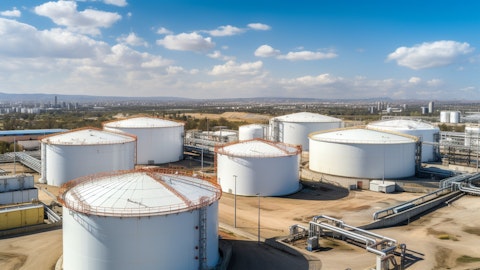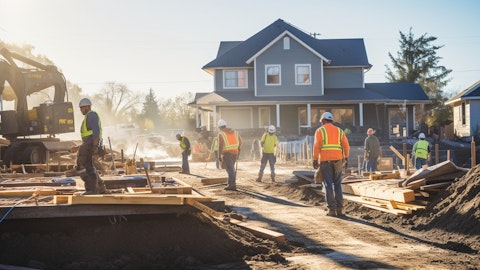Atmus Filtration Technologies Inc. (NYSE:ATMU) Q1 2025 Earnings Call Transcript May 2, 2025
Atmus Filtration Technologies Inc. misses on earnings expectations. Reported EPS is $0.537 EPS, expectations were $0.59.
Operator: Thank you for standing by. My name is Kayla, and I will be your conference operator today. At this time, I would like to welcome everyone to the Atmus Filtration Technologies First Quarter 2025 Earnings Call. [Operator Instructions] I would now like to turn the call over to Todd Chirillo, Executive Director, Investor Relations. You may begin.
Todd Chirillo: Thank you, Kayla. Good morning, everyone, and welcome to the Atmus Filtration Technologies first quarter 2025 earnings call. On the call today, we have Steph Disher, Chief Executive Officer; and Jack Kienzler, Chief Financial Officer. Certain information presented today will be forward-looking and involve risks and uncertainties that could materially affect expected results. Please refer to the slides on our website for the disclosure of the risks that could affect our results and for a reconciliation of any non-GAAP measures referred to on our call. For additional information, please see our SEC filings and the Investor Relations pages available on our website at atmus.com. Now I’ll turn the call over to Steph.
Stephanie Disher: Thank you, Todd, and good morning, everyone. Our team achieved another quarter of solid results by delivering industry-leading filtration solutions for our customers. I want to thank our global team for their dedication and hard work to start 2025. On the call today, I will provide a summary of our first quarter financial results and our outlook for 2025. I will also share our progress on executing our 4-pillar growth strategy. Jack will then provide a detailed review of our financial results. We continue to execute our capital allocation program. balancing share repurchases with a consistent dividend return. During the first quarter, we repurchased another $10 million of stock bringing our total amount repurchased since the program announcement last July to $30 million.
We had $120 million remaining under our Board authorization and expect to continue returning capital to shareholders throughout the remainder of the year. We have also made significant progress on our operational separation from our former parent Cummins and intend to complete remaining separation activities in 2025. Before providing an update on our growth strategy, I want to share our views on the current tariff environment. We have dedicated teams closely monitoring and taking actions in an environment, which is fluid. We largely produce in region-for-region, which has had the effect of reducing the impact of tariffs. This model allows us to efficiently serve our customers when and where they need us. In North America, we have manufacturing facilities in Tennessee and Wisconsin to support the United States, along with the manufacturing facility in Mexico.
The majority of our products from Mexico for the U.S. market are certified compliant or expected to be certified compliant under the USMCA trade agreement. While we have taken a regional focus, there are some products we source globally. The most substantial impact to date has been the significant tariff implemented on China. We have acted swiftly to adjust our pricing to reflect our increased costs and minimize the tariff impact on our business. Our pricing goal is to remain margin dollar neutral and pass through the increased costs we incurred to the market. We have a demonstrated ability to adjust pricing to reflect inflationary input costs. The estimated pricing from tariffs in 2025 is approximately 1.5%. This incorporates announced tariffs on China of 145% and U.S. broad-based 10% tariffs on other countries and assume substantially all Mexico products will be certified USMCA compliant.
It does not incorporate any impact from the Section 232 investigation the administration announced last week, which may impact tariffs for medium- and heavy-duty trucks and related parts. The outcome of this investigation is unknown. While pricing is an immediate action we can take, we are also assessing medium- and long-term actions, which can be implemented to reduce the impact of tariffs to our customers. With over 80% of our revenue derived from supporting our customers in the aftermarket, our business is fundamentally resilient. We will adapt as needed and continue to support our customers, while focusing on our growth strategy to drive shareholder value. Now let’s turn to the 4 pillars of our growth strategy and our progress in the first quarter.
Our first pillar is to grow share in first fit. We have realigned our organization and added resources to our account management teams to focus on first-fit growth. which is allowing us to achieve increased bid rates for new business opportunities. We continue to win with the winners as we partner with industry-leading OEMs as they grow their business and take market share. We are leaders in fuel filtration and crankcase ventilation. This leadership expanded earlier this year with the launch of our next generation of NanoNet media, NanoNet N3. This media enables compact filter designs, while delivering superior service life in the harshest environments across a wide variety of fuels. The reorientation of our organization for growth coupled with product and technology leadership allows us the continued opportunity to expand with new and existing OEMs around the world.
Our second pillar is focused on accelerating profitable growth in the aftermarket. Through our multichannel past to market, we are expanding market coverage of our industry-leading Fleetguard products. Additionally, we are increasing brand awareness through our We Protect campaign launched in the first quarter that focuses on our strengths, science that safeguards, championing a cleaner world and securing a better future. Furthermore, we are expecting the use — we’re expanding the use of advanced data analytic tools increasing our ability to provide industry-leading Fleetguard products for our customers when and where they need them. Our third pillar is focused on transforming our supply chain. We have transitioned 95% of our distribution network from Cummins with our most recent facility having opened late last year in Belgium.
We expect to transition our remaining facility in South Africa during the second quarter. During the first quarter, our team focused on bringing our Belgium location to a normalized operating level with a focus on improving customer experience. We all celebrated the grand opening of our newest media manufacturing facility in Mado, South Korea. The facility is designed to economically manufacture NanoNet Plus multilayer media and increased production capacity for our existing nanofiber line to meet growing market demand for premium performance filters. The plan also allows us to broaden our capabilities and make a large variety of media configurations to support a diverse range of our customer needs. Our fourth pillar is to expand into industrial filtration markets.

Our strategy remains focused on growth into industrial filtration, primarily through inorganic acquisitions. As a reminder, we are broadly looking at 3 verticals: industrial air, industrial liquids, excluding water and industrial water. In the near term, economic uncertainty and market volatility is softening M&A activity. However, we continue to review opportunities for inorganic expansion with a disciplined approach and a focus on delivering long-term shareholder value. Now let’s discuss our first quarter results. Despite challenging market conditions, our team delivered solid financial performance to start 2025. Sales were $417 million compared to $427 million during the same period last year, a decrease of 2.4%. While unfavorable foreign exchange was the most significant driver of lower overall sales, we continue to see soft market conditions in most of our global markets.
Adjusted EBITDA was $82 million or 19.6% compared to $80 million or 18.8% in the prior period. Adjusted EBITDA excludes $9 million of onetime stand-alone costs. Adjusted earnings per share was $0.63 in the first quarter of 2025 and adjusted free cash flow was $20 million. Adjusted free cash flow excludes $4 million of onetime separation-related items in the quarter. Now let’s turn to our market outlook for 2025. While we are confident in our ability to navigate the evolving tariff environment and adapt quickly, the overall impact on our end markets is less clear. We feel it is helpful to provide the market with guidance. However, our visibility in the current environment is limited. Given the heightened uncertainty, we want to provide as much transparency as possible regarding our underlying assumptions.
As and when those assumptions change, we will adjust future guidance appropriately. Our guidance does not assume a broad-based economic recession, and reflects tariff impacts, which are effective as of today. We expect tariff impacts to continue to evolve in response to ongoing policy and trade negotiations. Starting with the market guidance for aftermarket. Our recovery of freight activity is less certain than when we started the year. Previously, we expected freight activity to strengthen as the year progressed. Now we expect freight activity to continue at current levels. And the midpoint of our guidance is flat year-over-year, with a range of down 1.5% to up 1.5%. We continue to execute our growth strategy, which will enable us to outperform the underlying market.
Our outlook remains unchanged, and we expect our performance to add 2% on of aftermarket revenue growth. Pricing is expected to provide approximately 3.2% of year-over-year revenue increase. Pricing is comprised of 2 components: the first is base pricing actions to offset certain input costs, including steel, which is expected to be approximately 1.7%; the second component is tariff pricing. As I noted earlier, we are adjusting pricing approximately 1.5% in response to tariffs. While we expect to be margin neutral over the full year, we do expect some lag in the implementation of mitigation actions. While the U.S. dollar has weakened from the strength we saw in the first quarter, the currency environment remains fluid. We expect the full year of a strong U.S. dollar to be an approximate 1.5% revenue headwind.
Let’s now turn to our first-fit markets. In addition to economic uncertainty, the U.S. API announced in March a number of reviews of regulations for the U.S. heavy-duty market. Given these dynamics, we have not assumed any prebuy activity in our first-fit market outlook. In the U.S., we now expect the heavy-duty market to be down 5% to 15%. The U.S. medium duty, we expect production to be down 10% to 20%. We continue to expect demand for trucks in India to be flat to down as we have yet to see the ramp-up in government infrastructure spending. And in China, where we have low visibility to the market, we anticipate weak market conditions to continue. Overall, while the components of our revenue algorithm have changed, our expected total company revenue for 2025 remains in a range of flat to up 4%, compared to the prior year with global sales in an expected range of $1.67 billion to $1.735 billion.
We expect to react swiftly to changing market conditions and continuing — and continue delivering strong operational performance. Our expected adjusted EBITDA margin remains in the range of 19% to 20%. Lastly, adjusted EPS is expected to be in a range of $2.35 to $2.60. While the tariff environment remains fluid, we are confident in our ability to navigate these challenges and deliver strong shareholder value. Now I will turn the call over to Jack, who will discuss our financial results in more detail.
Jack Kienzler: Thank you, Steph, and good morning, everyone. Despite challenging markets, our team delivered another quarter of solid financial performance. Sales were $417 million compared to $427 million during the same period last year, a decrease of 2.4%. The decrease in sales was primarily driven by unfavorable foreign exchange of 3% and lower volumes of 1%, partially offset by pricing of 1%. Gross margin for the first quarter was $111 million compared to $112 million in the first quarter of 2024. In addition to foreign exchange and volumes, we were also unfavorably impacted by onetime separation and logistics costs, partially offset by pricing, lower manufacturing costs and favorable warranty costs. Selling, administrative and research expenses for the first quarter were $55 million, an increase of $2 million over the same period in the prior year.
Joint venture income was $9 million in the first quarter, down $1 million to our 2024 performance. This resulted in adjusted EBITDA in the first quarter of $82 million or 19.6% compared to $80 million or 18.8% in the prior period. Adjusted EBITDA for the quarter excludes $9 million of onetime stand-alone costs. Completing the transition of our Belgium warehouse from Cummins was complex and required more resources than originally anticipated. As a result, we incurred higher costs to minimize the impact to our customers. As a result of these higher Q1 costs, we are revising our full year guidance for onetime costs to now be in a range of $10 million to $15 million. Adjusted earnings per share was $0.63 in the first quarter of 2025 compared to $0.60 last year.
Adjusted free cash flow was $20 million this quarter, compared to an outflow of $13 million in the prior year. Lower incentive compensation payments and more efficient use of working capital drove improved performance this year. Free cash flow has been adjusted by $4 million for capital expenditures related to our separation from Cummins. We expect onetime capital expenditures related to our separation activities from Cummins to be complete this year and these costs to be in the range of $5 million to $10 million for 2025. The effective tax rate for the first quarter of 2025 was 21.3% compared to 22% last year. The decrease was driven by a change in the mix of earnings among tax jurisdictions. Now let’s turn to our balance sheet and the operational flexibility, it provides us to execute our growth and capital allocation strategy.
We ended the quarter with $183 million of cash on hand. Combined with the full availability of our $400 million revolving credit facility, we have $583 million of available liquidity. Our strong liquidity position provides us with the operational flexibility in the current dynamic market to effectively manage our business and execute on growth opportunities. Our cash position and solid — continued solid performance to start 2025 has resulted in a net debt to adjusted EBITDA ratio of 1.2x for the trailing 12 months ended March 31. In closing, I want to thank our global team for their hard work and dedication to deliver solid performance for the start of 2025. Now, we will take your questions.
Q&A Session
Follow Atmus Filtration Technologies Inc. (NYSE:ATMU)
Follow Atmus Filtration Technologies Inc. (NYSE:ATMU)
Receive real-time insider trading and news alerts
Operator: [Operator Instructions] Our first question comes from the line of Jerry Revich with Goldman Sachs.
Jerry Revich: And nice quarter in the challenging environment. I wanted to ask if we think about the possible manufacturing transitions that are feasible for your business over time, Steph, can you just give us a broad feel for what that might look like if some of these tariffs are here to say, how much can you alter your supply base if we see visibility on long-term tariffs?
Stephanie Disher: Thank you. Good to talk to you. Look, I think it may be useful just to start with a broader articulation of tariffs and impact. I think in the near term, really the mitigation actions that we are focused on is, first and foremost, ensuring we avail ourselves of the certifications or the exemptions available under the USMCA certification. So we have a significant manufacturing facility in Mexico that supports some of our aftermarket requirements in the U.S. And we are really working hard to avail ourselves of USMCA certifications and the exemptions available there. In the short term, we are also focused on looking at the routing of our delivery routes around the world and where it makes sense for the flow of our product to go and what adjustments we can make on resourcing of product and our distribution flows.
And so they are the primary short-term focus in terms of manufacturing transitions. I would say we’re not contemplating at this point any long-term manufacturing changes. We’re well established in the U.S. We have a strong presence, can certainly talk more to the broader outlook of tariffs and their impact on us. I covered a lot of that in my script as well. We’re constantly monitoring the situation, but not planning any long-term manufacturing shifts at this stage.
Jerry Revich: Super. I appreciate the color. And then a challenging environment for a range of industrial companies. To what extent is this environment potentially helping drive a more active M&A pipeline? Can you just give us an update given how fragmented some of the competitors are on the industrial filtration side. Should we be optimistic about this environment creating an opportunity for you folks to potentially close some deals.
Stephanie Disher: Certainly. We are very focused in our leadership team and in the broader organization on staying focused on our growth strategy. And we’re really focused on those things that we can control in what is a very noisy environment right now. So as you rightly point out, expansion into industrial filtration through an M&A strategy is still core to our direction and our growth strategy, and we’re very focused on that. We’ve got our team continuing to work on it. We are continuing to evaluate a range of targets in our M&A pipeline. I do want to acknowledge, as I did in my opening comments, the market has made that degree of difficulty a little higher, I would say, just in terms of the availability of targets given the uncertain landscape, and we’ll have to continue to evaluate that.
But we remain focused on building a strong pipeline of M&A, assessing those targets alongside our strategic criteria and financial criteria, and have that as a core part of our growth strategy for the future.
Operator: And your next question comes from the line of Rob Mason with Baird.
Rob Mason: Steph, I certainly appreciate all the detail that you provided around the movements on the top line. I guess — could you summarize real quick if you think about all those puts and takes between currency, pricing, changes in your market view? Do you still essentially shake out near the midpoint of your revenue range? I know it didn’t change, but just within the range, how do all those shake out?
Stephanie Disher: I think that’s the right way to read it. Good morning, Rob, by the way. I think that’s exactly the right way to read it, that it shakes out about the midpoint. I think certainly, since our previous guidance, we have seen a softening in the market. I talked about in the aftermarket that previously, we were expecting a rebound in the second half of the year or an increased set of freight activity in the second half of the year, particularly given we’ve been in pretty depressed conditions from a freight activity perspective for some time. I do feel like I’m repeating a story from last year. I was expecting it to come back last year in the second half. And — so now we have assumed that it’s really flat year-over-year at the midpoint for aftermarket guidance.
And then obviously, we continue to see downward pressure on the first-fit market, which is a much lower exposure for us. We’re now north of the 80% in aftermarket in terms of our latest ratio of aftermarket to first-fit given to what given — due to the part of the cycle that we are in, and we have not assumed any prebuy activity inside 2025 on the first-bit side. And so I think that’s the market outlook. And then, of course, you see the pricing associated with tariffs coming into our guide now, which was not there when we guided previously, and that is offsetting some of this market softness.
Rob Mason: Sure. And then just as a follow-up, you did not change your contribution you expect from market share. So I’m curious just with market volumes moving around your ability to add that extra couple of points of revenue. Has there been any developments, incremental developments on the market share side?
Stephanie Disher: It’s a great question and one we’re certainly continuing to have with our team. We are very focused on continuing to grow share, whilst that — I think the challenge to that, if I just describe it, that gets more challenging in the environment that we’re in, is just the slowing of decision-making in different companies when you’re trying to gain share. I’ve been given a lot of shares, was anticipated in the aftermarket, around our coverage, and we had it pretty well underpinned, is what gives us the confidence to still confirm that guidance in market share gains. That is something we’re closely monitoring. More related to decision-making by our end customers to enable us to be able to continue to make that share — those share gains.
Operator: And your next question comes from the line of Tami Zakaria with JPMorgan.
Tami Zakaria: So my first question is on pricing. I think you’re expecting you said 3.2% for the year, and the first quarter was about 1 point. And so should we expect pricing to accelerate to about 4% in 2Q and hold that rate for the rest of the year to get to that 3.2% or does pricing ramp throughout the year, and then eventually at a high rate in 4Q that gets us to 3.2% for the full year?
Stephanie Disher: Yes. Jack, do you want to take that one?
Jack Kienzler: Yes, sure. So the way I would think about it is a little bit more of a ramp versus being even each quarter, just as we have both the base pricing actions as well as the midyear kick in here on — in July. So it’d be more like a — just a touch over 3%, I would guess, in the second quarter and then build up into between the 4% and 5% range in Q3 and Q4.
Tami Zakaria: Got it. That’s super helpful. And then second question on tariffs. I appreciate the detailed comments, and I acknowledge, it’s very fluid right now. But just for our understanding, let’s say, Section 232 goes into effect and USMCA exemption no longer exists, but then China tariffs are rolled down or rolled back to some — in decent level or a reasonable level, so between those 2, would Section 232 impact be offset by a rollback of China? Or how should we think about if one goes down and the other comes into effect, have you done any scenario analysis on that?
Stephanie Disher: We have done lots of scenario analysis, Tami. And so let me try and answer your question as the best I can without getting to hypotheticals — on hypotheticals about what might be. What I’d like to do as I answer the tariff question. I do really want to start with thanking and appreciating our team. Really, it is — I’ve had the privilege of seeing Atmus teamwork at its absolute best in response to the evolving tariff landscape. We’ve had a task force set up led by Charles Masters, the President of our Power Solutions business and supported in leadership by Paul Massey, our Vice President of Supply Chain and this really has been a total company effort, our trade team, our legal team, our procurement team, our sales team and just to see that working together not only within the U.S., but globally has really — is really what has enabled us to get our arms around this impact quickly and implement mitigation actions.
That is the key actually to what will put us in good shape as we move forward, no matter the landscape on tariffs. So I just wanted to start with that. If I then talk about what is the impact of tariffs today? What are the mitigation actions we’re taking, and then how do I see the unknown playing out in the future? And how will we respond to those. So if I just start with the impact today, really, I would break that down into 3 key areas. The first and most significant at the moment by far is China. Whilst we only import less than 2% of our U.S. sales from China, as we’ve previously shared, we’re very much a region-for-region strategy, but we do import some of our products from China. 145% of anything is a big number. So that is by far the majority of our impact today.
We then have — the second part is tariffs from Mexico. With our largest manufacturing plant in Mexico and that’s supporting the aftermarket in the U.S. that has the potential to be larger than that China impact is how I would describe it. Right now, that impact is much lower because of the high proportion of USMCA certification that we have already and are moving towards. And so — and then the third category of impact is the broad-based sort of 10% on other countries, which is a much lesser impact given our region-for-region strategy. So there are the impacts, as I see them right now, in terms of the mitigation of the way we are approaching mitigation is, first and foremost, to try and put in place actions that can mitigate the cost of tariffs for our customers.
So the biggest one there is the certifications under USMCA and prioritizing that. The second activity is some of the short-term measures in the supply chain that we are taking delivery rerouting, so that we don’t have product coming through the U.S., but then inevitably goes out again. So really looking at those delivery pathways and where we might be able to resource in a short-term way, product manufacturer. And then the — after taking all of those measures and trying to reduce the impact of tariffs, we are then — our principle is to really pass the cost of tariffs to the market through pricing. And our principle is to ensure margin neutral — margin dollar neutral, as we pass that pricing to the market. Given our high aftermarket business, parts business, we’re confident in our ability to pass pricing to the market, and that’s how we would progress.
In terms of the future uncertainties and what might happen from here, you point out the Section 232 investigation. I would expect us to follow these same principles in the application of those potential outcomes. So we’ll assess the outcome. We’ll look to avail ourselves of all exemptions available. We’ll look to minimize that impact to customers and where we are not able to minimize that — reduce that or eliminate that impact, we will pass that cost to the market through pricing.
Operator: And your next question comes from the line of Andrew Obin with Bank of America Merrill Lynch.
David Ridley-Lane: This is David Ridley-Lane on for Andrew Obin. So I think the supply chain crisis a few years back, you were slower to pass through pricing. I’m wondering, not to put too finer point on it, but do your contracts with the OEMs on the first-fit side? Is there something different this time that allowed you to pass through the pricing on tariffs so quickly?
Stephanie Disher: It’s a great question. And I do think we did lag a bit in the supply chain crisis. And we heavily relied on — really the twice a year in the U.S. pricing actions during that time, right? So is the January and the July as an example, with a notice period, which meant you had a long lag in the aftermarket. We have already taken the pricing actions it related to tariffs. We have already informed our customer base that we intend to take pricing action immediately on tariffs rather than apply the January and July timing for the aftermarket, which is the majority of our business. And so that’s the first thing I would say on the lag. The lag impact will still exist somewhat. So we’ll be watching the second quarter here closely as we look to implement the mitigation measures because it takes some time to scale those up, not just the pricing, but the other dimensions of mitigation measures as well.
And on the first-fit side, much lower proportion of our business, but obviously, that’s on a contract-by-contract basis, and it varies based on where that impact is. And so we’ll look to work through that with customers and to be able to pass that price through to our customers.
David Ridley-Lane: Got it. And is the tariff situation can be different for some of your competitor set. Is there any silver lining here in that perhaps some of your European-based firms export from Europe or some of your other competitors have low-cost manufacturing elsewhere in other regions and are importing, is there any benefit on a competitive set that might help you on the market share gains?
Stephanie Disher: I think it’s a good question. And we have looked at some of this from a scenario planning perspective, I don’t think there’s a major relatively difference either way, to be honest, there will be puts and takes at a product level. But overall, as you aggregate that up, it’s not something where we’re lying on in our guidance. And also, we’re not assuming a relativity downside the other way either. So obviously, we’ll have to manage this at an individual product level as it plays out, at an individual customer level to make sure we’re supporting our customers, and we’re winning with our customers every day. That’s at the heart of where this needs to happen. But at an aggregate level, the best guidance I can provide you right now. I don’t expect significant share gains associated with tariffs, and I don’t expect significant share losses.
Operator: And your next question comes from the line of Bobby Brooks with Northland Capital.
Bobby Brooks: So with all the noise regarding the EPA and potentially rolling back some emissions, and I know it’s near impossible to quantify the headwind, it would cause if this 2027 rules get acts. But I was kind of more curious on how would a rollback of emission standards that have been acted over the last 4 to 5 years impact the business?
Stephanie Disher: It’s certainly something — Bobby, it’s certainly something we’re looking at closely. In March, obviously, the EPA announced a number of regulations opened up for review. I think the announcement I read was about 31%, and that includes the standards on NOx that were due to come into effect in the 2027 model year production, so that’s now under review. We’re not sure exactly how that review is going to come out. I think we’re also reviewing EV mandates and a number of other things as part of the regulatory review. We’re monitoring that to understand the implications. Here is how I would characterize it. I think we’re very well positioned as we look ahead. So — we are a global leader in filtration solutions.
We sit at the table with leading OEMs and have relationships with the leading OEMs around the world. And we have solutions that we’re providing them today that meet today’s regulations. We are also very capable to meet their needs for future regulatory requirements and have already in production and planning for that with our OE partners. So the way I — we’ll have to see how the regulatory environment plays out. We’re already supporting our customers at today’s level of regulatory requirements; we will be ready to support if the regulation goes in. And then we also will continue to support our customers if it stays where it is today.
Bobby Brooks: Got it. That’s helpful color. And I guess just a follow-up on that is, given how strong the relationship you guys have with these OEMs across the globe, what — is it your sense would OEMs actually start to change their future designs to spec in less emissions tech? Or would truck owners or would maybe truck owners and operators pay to pull these systems out. I feel like that’s kind of unlikely, but just curious to hear what you’re hearing from your customers.
Stephanie Disher: Yes. I think I wouldn’t speculate on any of that at the moment. I think the review has only just been opened not sure exactly how that review is going to play out. I do think, obviously, we’ll all need to monitor that and then understand how do our customers need to approach that evolving landscape to their business and therefore, how do we best support them. I think one of the things that’s giving me a great deal of optimism, I would say, when you take a company public, you stand it up, you need to deal in a much more agile way as a team. You certainly do learn how to operate in an uncertain environment. And so I guess I would just finalize my question — my response to your question here by saying. I really think it’s the team you’ve got in place, their ability to navigate in a changing landscape, that equips you as things emerge. But too early to speculate on that from my perspective.
Bobby Brooks: Fair enough. And I appreciate the color. And just one last one for me. On my call back last quarter, Jack, you gave some great color about how Atmus could reconfigure some shipping routes to help avoid tariffs. And Steph, you touched on it a couple of times in the Q&A, but I think it would be really beneficial to just double-click on some of those — some of the examples of how you could reconfigure some shipping routes? And then secondly, I was just curious if these potential reconfigurations, it seems like some of them might have already started to happen? Or are they still just a plan and not necessarily going yet?
Stephanie Disher: Yes, go ahead.
Jack Kienzler: Thanks for the question, Bobby. Yes. So if you take the mitigation actions that Steph was highlighting, really, what we’ve done is try to analyze and quantify the tariff exposure. And then the first actions that we look to take are what can we do to mitigate that impact so as to mitigate any ultimate impact that goes to our customers. And so — those types of shipping lane reconfigurations are certainly a part of that as well as looking at resourcing, so on and so forth, as you can imagine. As you know, we have enacted some actions already on that page. And then as we’ve also taken advantage of a number of different exceptions available to us. And so as we work through that list, and exhaust that list, that’s when we turn to price to really look to stay margin neutral. So yes, we have put those in place in a number of different areas, and we will look to continue to identify other mitigation areas as and when they become clear to us.
Operator: And there are no further questions at this time. Todd Chirillo, I’ll turn the call back over to you.
Todd Chirillo: Thank you. That concludes our teleconference for the day. Thank you all for participating and for your continued interest. Have a great day.
Operator: This concludes today’s conference call. You may now disconnect.
Follow Atmus Filtration Technologies Inc. (NYSE:ATMU)
Follow Atmus Filtration Technologies Inc. (NYSE:ATMU)
Receive real-time insider trading and news alerts





